
On the way...
West Coast Fossil Park in Langebaanweg is a world-renowned fossil site dating to circa 5.2 million years ago, which is the terminal Miocene/early Pliocene period.
It is located approximately 150 km north of Cape Town and known for its exceptionally well-preserved fossil faunal remains. It is a 14-hectare area declared the National Heritage Site.
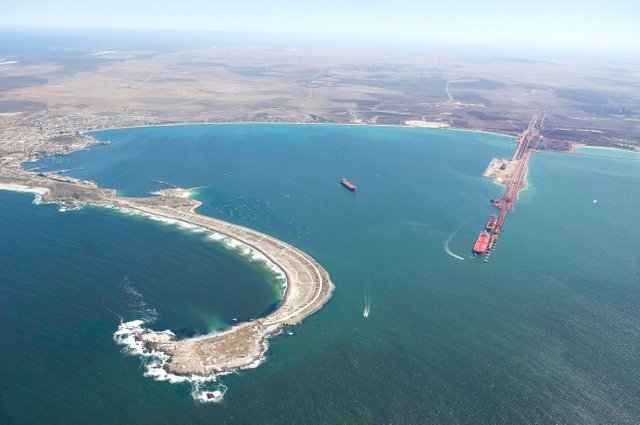
Saldanha Bay
The highlight of the Park is the ‘in situ’ exhibit of an ongoing excavation, undertaken by a team of national and international researchers, in attempt to recreate unique history of fossils and the environment and climate of the west coast. 5 million years ago it had a subtropical climate, open grasslands, riverine and lush forests. Animals such African bears Sivathere (Shiva’s beast) – short necked giraffes, sabre-toothed cats, hyenas that are now extinct, were roaming freely in this area.
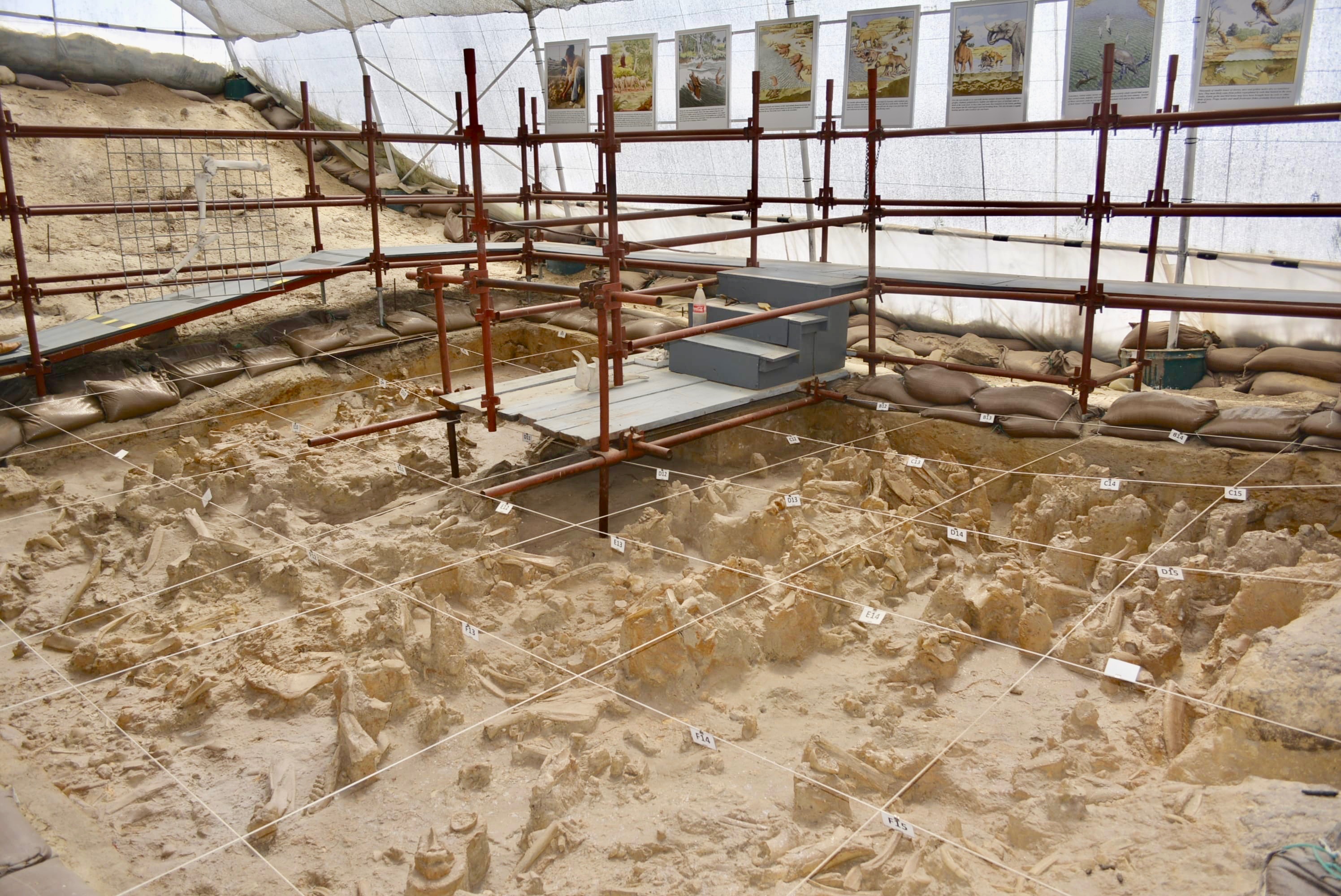
Fossils in situ
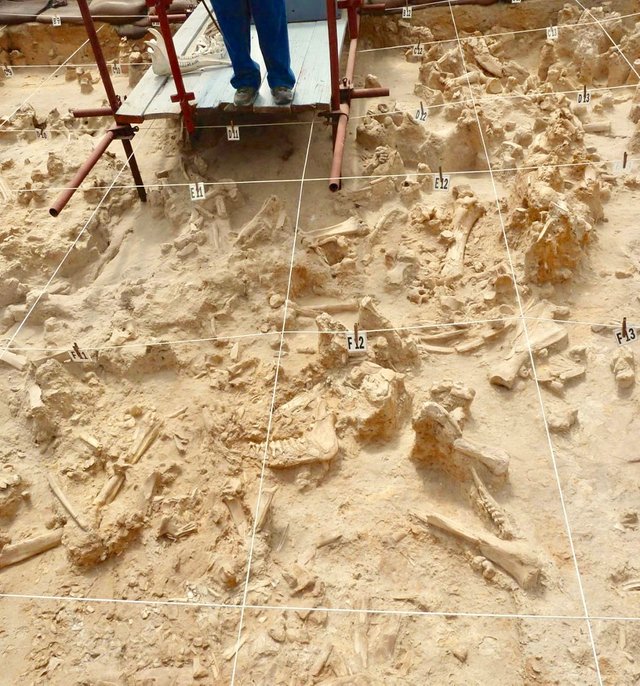
Fossils in situ
Phosphate mining operations at Langebaanweg area uncovered deeply buried fossil deposits, representing possibly the greatest diversity of five-million-year-old fossils, one of the richest the world has ever seen. Some of the animals excavated were unknown to the world of science, overall 200 different kinds of animals have been exposed.
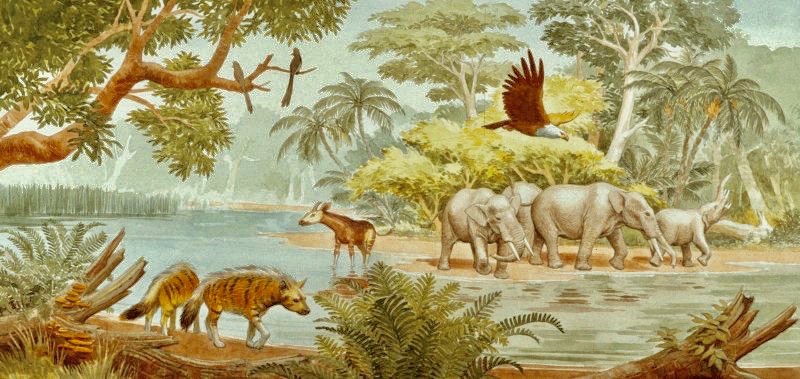
Illustration
In this area the phosphates come from the Varswater Formation.
The mining operations started in 1943 at Baard’s Quarry. At the time the solid phosphate rock was initially mined for fertilizer and for use in World War II armaments. This activity may have destroyed many tons of fossils. Even 80% is believed to have been crushed up along with the rock but estimated 1 million specimens got successfully preserved.
The mining moved from Baard’s Quarry to the nearby ‘E’ Quarries and Varswater ”C” in the early 1960’s.
The operations ceased altogether in 1993. And in 1996, the 14 ha fossil-rich area was secured and declared a National Monument Site. Subsequently approximately 700ha- the entire mine area was declared a National Heritage Site.
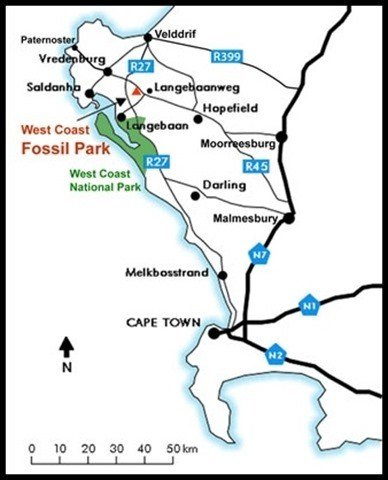
Map of the region

The river delta
The region existed in a subtropical woodland near where an ancient Berg River emptied into the Atlantic. Previously underwater now exposed on land, due to changing conditions. Attainable for excavation and detection. This area was near the boundary of land and ocean and in regions of high marine biologic productivity, sedimentary phosphate deposits are being produced. Like in the continental shelves the animals found there together are both marine animals and land mammals. The list here includes seal, megalodon shark, 4 species of penguin, Sivathere-short-necked giraffe, aardvark, hyena, hippo, mammoth, antelope, three-toed horse, saber-toothed cat.
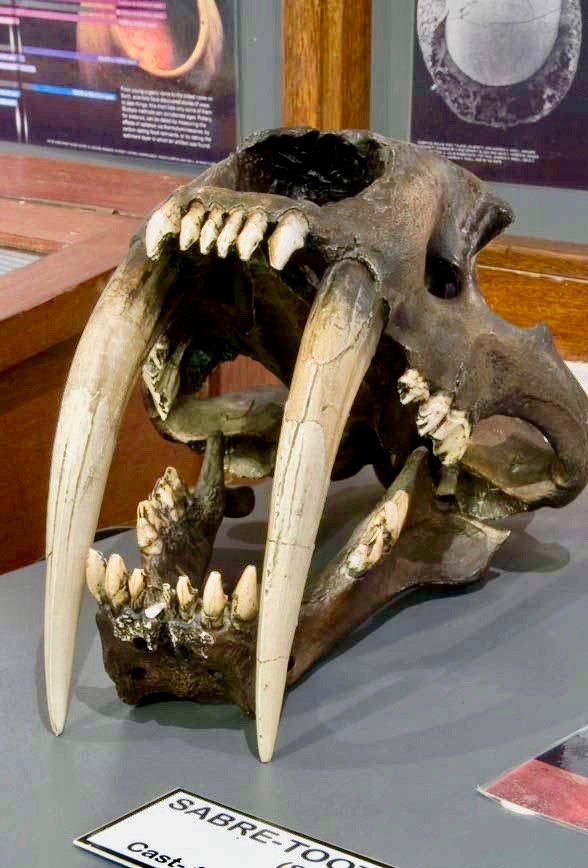
African Bear scull

African Bear
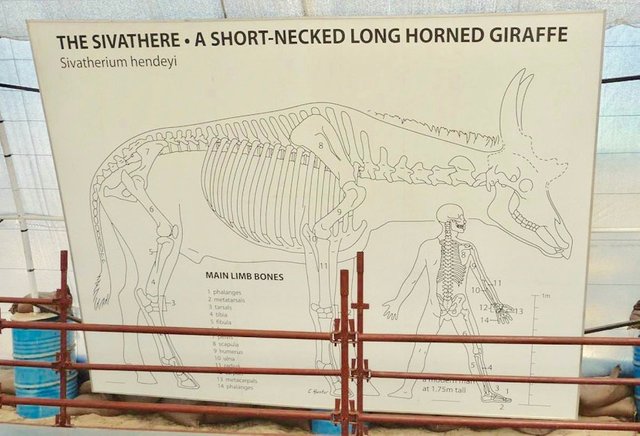
Sivathera-Shivas Beast
The fossilization process is commonly understood as animal dying and then being buried in place. At the West Coast Fossil Park in this single location many of the remains were moved by the water and concentrated over time.
Thought to have been laid down during a time period when the sea level was rising -the so called marine transgression. The conditions during glacial periods are drier and more arid and therefore usually the dust in the air increases. Cores taken from the ocean floors allow to trace such periods and may be used to record glacial or cooler periods.
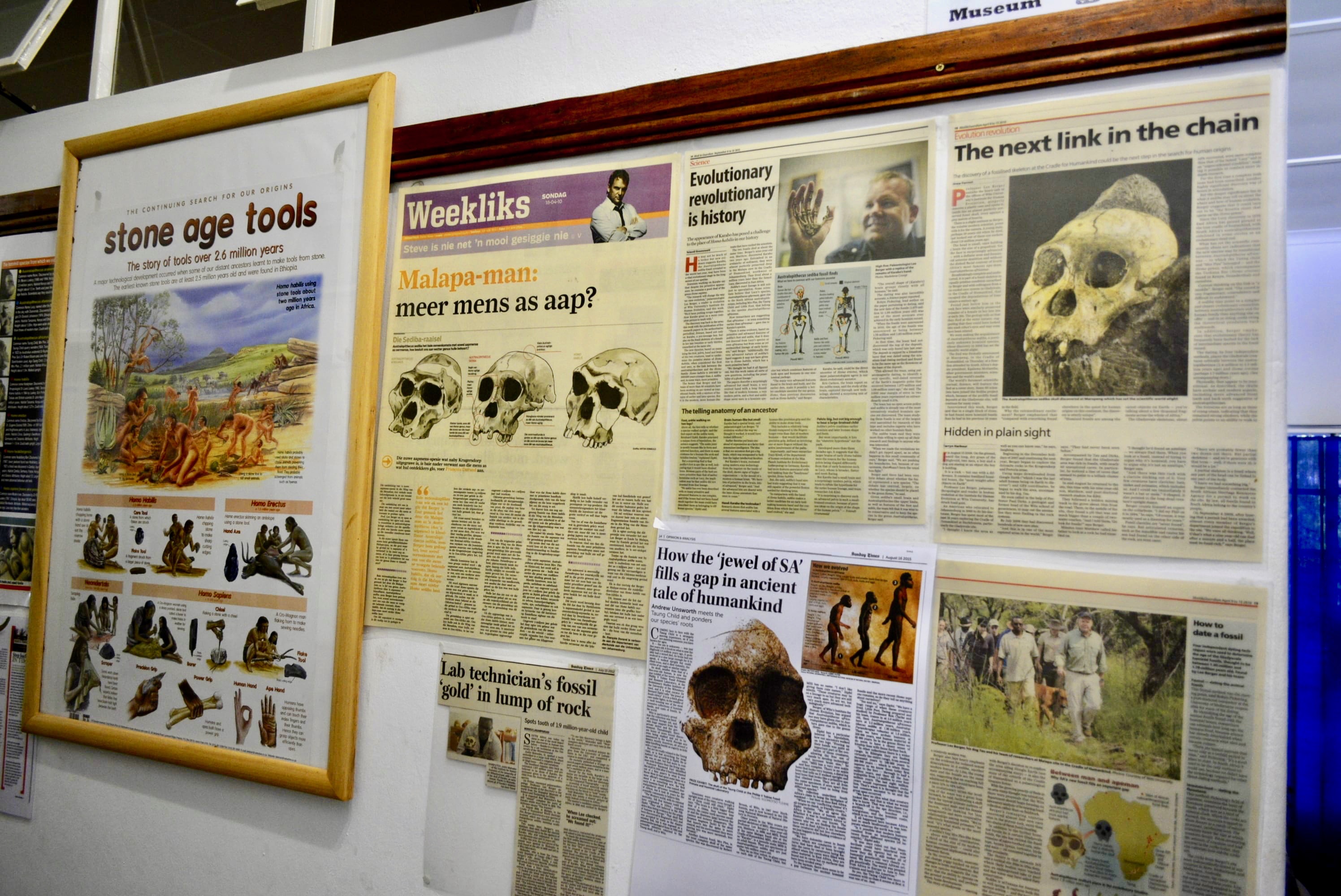
In order to understand Earth's past and reconstruct an environment, pieces of evidences is being combined. Finding pockets of concentrated, or highly detailed fossils is scientifically valuable and generally remains of a rare occurrence.
Within these fossil beds one can find an important information about which animals lived in a region and the depositional setting. The numerous remains show specifically important clues in the sediments surrounding the bones, biologic communities and climate of the region around 5 million years ago.
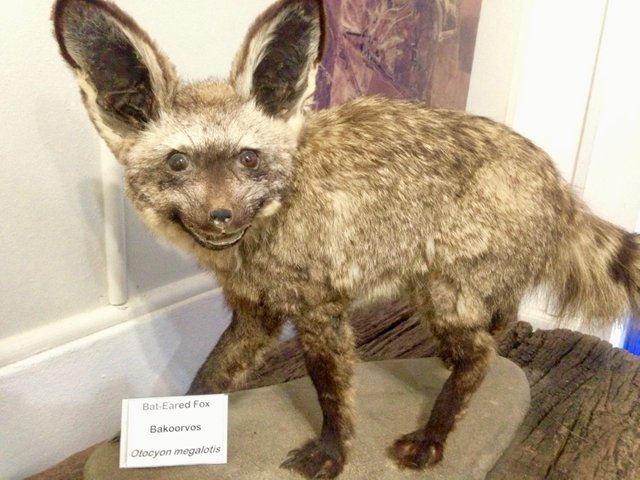
Bakoorvos
Various plants and animals have diverse habitat needs. The clues about past ecosystems are provided by identifying the remains of them.
All of these bits of evidence can be combined to create detailed reconstructions of environments that existed millions of years ago. Recovered from archaeological and paleontological sites the fossilised teeth and bones are being studied in order to identify how animals lived and behaved before being extinct.

Wild African cat
To identify an animal, it is not necessary to have 100% of an individual’s bones.
Influenced by what plants the animal consumed, bones can be analysed for their isotopic compositions. Particularly useful are teeth, because of extremely durable and strong biological substance- capped on them enamel.
The type of plants and trees can be identified by the seeds, pollen grains, fossil wood and charcoal found in the area. Despite their tiny size the pollen grains are amazingly durable.
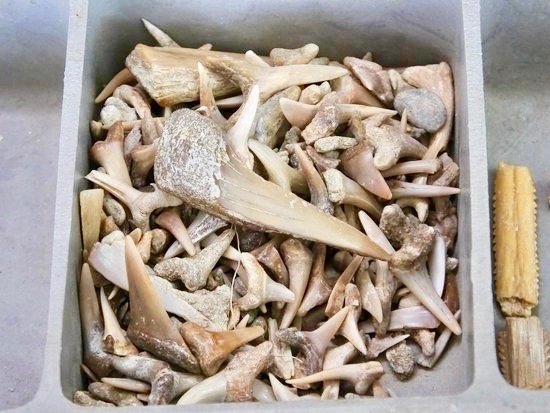
Fossils
The science provides a number of commonly used paleo environmental analysis. Some are chemical, some visual.
In nature there are three varieties of the same chemical element, carbon isotopes: 12C, 13C and 14C.
Due to its use in dating remains, isotope C-14 is most familiar, other common and not radioactive isotopes are C-12, and secondary stable C-13. Being stable, they do not decay over time.
C3 and C4 plants fractionate carbon isotopes in distinctly different ways and it is this feature which makes them suitable for paleo environmental analysis. By studying the carbon isotopes in animal/human bones or teeth the diet of the living animal can be extrapolated from the carbon 13 to carbon 12 ratio. The scientific way of writing this is 13C /12C. The 13C /12C ratio of fossil bones or teeth thus reflect the diet of an animal or human. If a sample has a relatively high ratio of 13C /12C, it means the animal ate a diet rich in C4 plants. If the animal is a carnivore it would indicate that they ate animals which were in turn eating the C4 plants.
http://www.fossilpark.org.za/pages/sc-eat.html
Currently the park is located 10 km from the ocean in a Mediterranean climate. Visitors Centre offers a daily guided fossil tours to the Dig Site the laboratory and the museum.
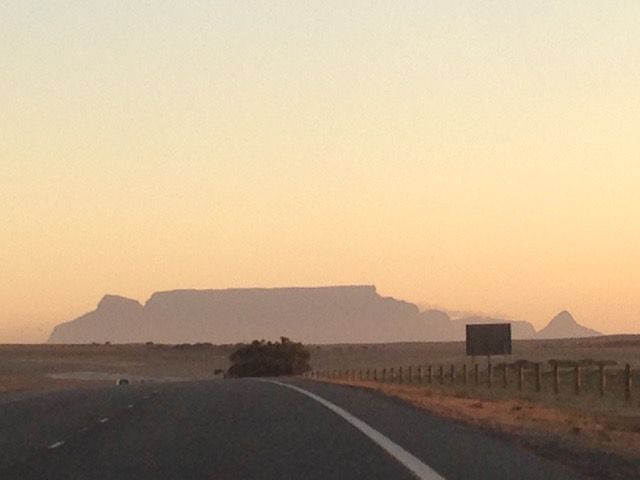
View of Table mountain on the way to Cape Town
*Photographs taken by @highonthehog
*Other sources : linked below photographs.
https://www.royalsocietysa.org.za/?page_id=1110
https://depositsmag.com/2017/08/15/the-west-coast-fossil-park-western-cape-south-africa/















Being A SteemStem Member
Deeply grateful Team! Thank you, have a truly wonderful day !
DISCLAIMER: dropahead Curation Team does not necessarily share opinions expressed in this article, but find author's effort and/or contribution deserves better reward and visibility.
to maximize your curation rewards!
with SteemConnect
12.5SP, 25SP, 50SP, 100SP, 250SP, 500SP, 1000SP
Do the above and we'll have more STEEM POWER to give YOU bigger rewards next time!
News from dropahead: How to give back to the dropahead Project in 15 seconds or less
You received a 10.0% upvote since you are not yet a member of geopolis.
To read more about us and what we do, click here.
https://steemit.com/geopolis/@geopolis/geopolis-the-community-for-global-sciences-update-3
If you do not want us to upvote and comment on your posts concerning earth and earth sciences, please reply stop to this comment and we will no longer bother you with our love ❤️
Guys, thank you very much. If you like my posts feel free to upvote , I will not say no ;)
The cat really looks wild :D
I like the eyes they gave him!
The eyes tell everything :)
Those eyes tell me he wants to eat me in a nightmare Doctor Seuss kind of way!
Congratulations, Your Post Has Been Added To The Steemit Worldmap!
Author link: http://steemitworldmap.com?author=highonthehog
Post link: http://steemitworldmap.com?post=5-million-years-ago-shiva-s-beast-and-other-south-african-fossils
Want to have your post on the map too?
Nice
ilginç
It's amazing what we can do with today's science technology... so much information in the bones. I never realized how much you can see from the past!
That Bear skull is really impressive...kind of glad these guys aren't around anymore, they're scary. And that wild cat, some eyes they put on him, I like it!
200 different kinds of animals have been exposed that's very cool.
Thanks for the photos and the knowledge.
Yup, freaky cat eyes, my favourite. I have some more specimens in my photocollection of taxidermic animals ..
I guess realistic eyes are hard to make ... something about the lack of movement maybe!
wow! that looks amazing. I really want to go to South Africa because i love fossils and excavations! Hopefully the water situation gets better, I saw it on the news :S
Well, there is a lot to learn. I'm travelling there in march so hopefully it will get better, don't want to steal the last drops of water.
such an amazing country we have here